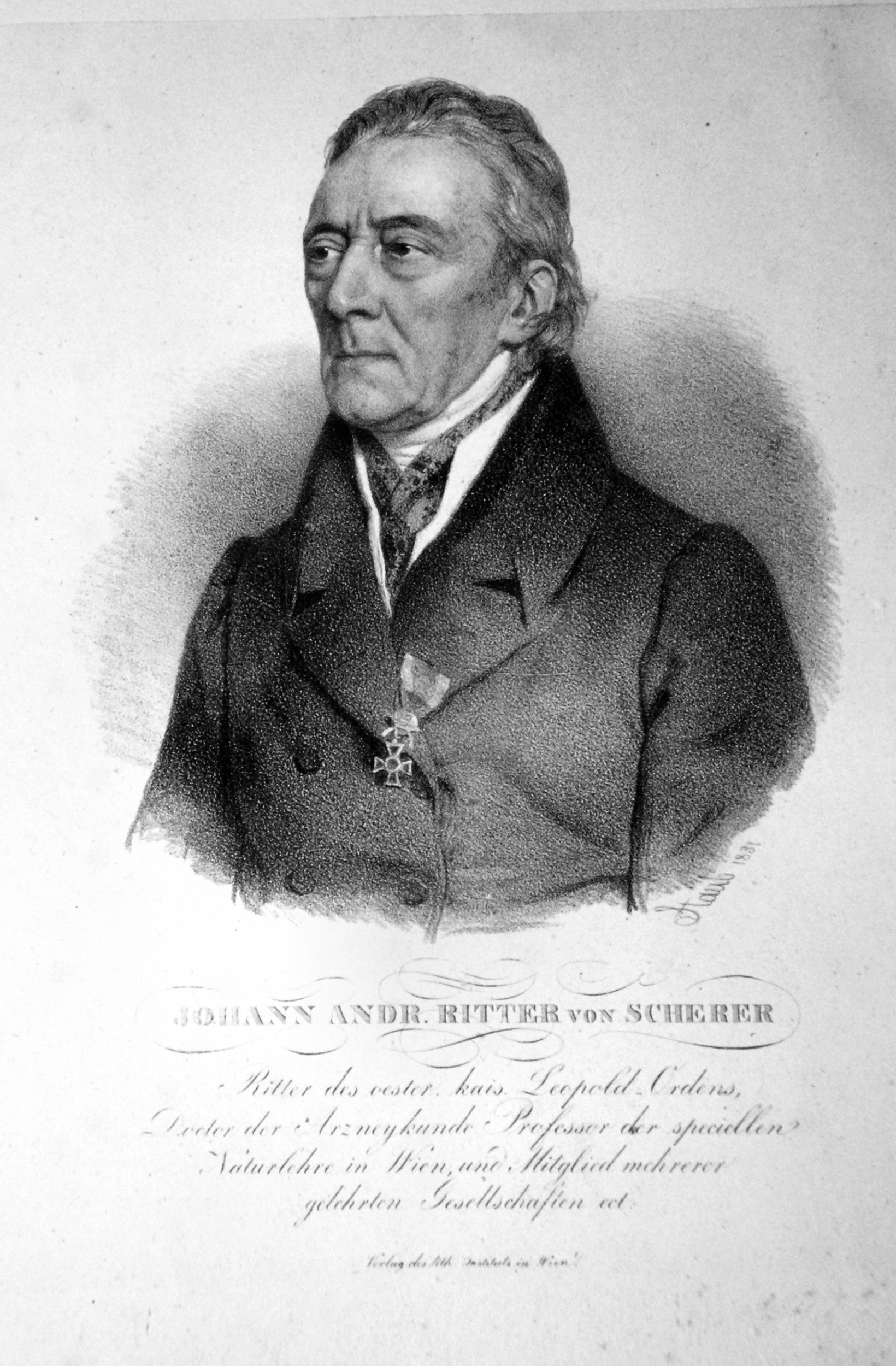Johann Andreas Scherer on:
[Wikipedia]
[Google]
[Amazon]
 Johann Baptist Andreas Ritter von Scherer (24 June 1755 – 10 April 1844) was an Austrian
Johann Baptist Andreas Ritter von Scherer (24 June 1755 – 10 April 1844) was an Austrian
ZVAB.com In 1811 he was elevated to the status of "
Most widely held works by Johann Andreas Scherer
WorldCat Identities
chemist
A chemist (from Greek ''chēm(ía)'' alchemy; replacing ''chymist'' from Medieval Latin ''alchemist'') is a graduated scientist trained in the study of chemistry, or an officially enrolled student in the field. Chemists study the composition of ...
and botanist
Botany, also called plant science, is the branch of natural science and biology studying plants, especially Plant anatomy, their anatomy, Plant taxonomy, taxonomy, and Plant ecology, ecology. A botanist or plant scientist is a scientist who s ...
.
Scherer was born in Prague
Prague ( ; ) is the capital and List of cities and towns in the Czech Republic, largest city of the Czech Republic and the historical capital of Bohemia. Prague, located on the Vltava River, has a population of about 1.4 million, while its P ...
. He studied chemistry at the universities of Prague
Prague ( ; ) is the capital and List of cities and towns in the Czech Republic, largest city of the Czech Republic and the historical capital of Bohemia. Prague, located on the Vltava River, has a population of about 1.4 million, while its P ...
and Vienna
Vienna ( ; ; ) is the capital city, capital, List of largest cities in Austria, most populous city, and one of Federal states of Austria, nine federal states of Austria. It is Austria's primate city, with just over two million inhabitants. ...
, receiving his doctorate in 1782. As a student his instructors included botanists Joseph Gottfried Mikan and Nikolaus Joseph von Jacquin
Nikolaus Joseph Freiherr von Jacquin (16 February 172726 October 1817) was a scientist who studied medicine, chemistry and botany.
Biography
Born in Leiden in the Netherlands, he studied medicine at Leiden University, then moved first to Par ...
. In 1797 he became a professor of chemistry at the Theresianum
Theresianum (or Theresian Academy; ) is a private Boarding school, boarding and day school governed by the laws for public schools in Vienna, Austria. It was founded in 1746 by Empress Maria Theresa of Austria.
History
Early history (1614–1 ...
in Vienna, followed by a professorship at the Polytechnic Institute in Prague (from 1803). From 1807 to 1834 he was a professor of specialized natural history at the University of Vienna
The University of Vienna (, ) is a public university, public research university in Vienna, Austria. Founded by Rudolf IV, Duke of Austria, Duke Rudolph IV in 1365, it is the oldest university in the German-speaking world and among the largest ...
.Scherer, Johann AndreasZVAB.com In 1811 he was elevated to the status of "
Ritter
Ritter (German for "knight") is a designation used as a title of nobility in German-speaking areas. Traditionally it denotes the second-lowest rank within the nobility, standing above " Edler" and below "" (Baron). As with most titles and desig ...
" (title of nobility). From 1832 he was an editor of the ''Österreichischen medizinischen Jahrbücher''. He died in Vienna
Vienna ( ; ; ) is the capital city, capital, List of largest cities in Austria, most populous city, and one of Federal states of Austria, nine federal states of Austria. It is Austria's primate city, with just over two million inhabitants. ...
.
Selected works
* ''Eudiometria sive methodus aeris atmosphaerici puritatem salubritatemve examinandi'', 1782 ( dissertation thesis). * ''Geschichte der Luftgüteprüfungslehre für Aerzte und Naturfreunde'', 1785 – History of air quality testing for physicians and lovers of nature. * ''Versuche mit Pflanzen'', 1786 (translation ofJan Ingenhousz
Jan Ingenhousz FRS (8 December 1730 – 7 September 1799) was a Dutch-British physiologist, biologist and chemist.
He is best known for discovering photosynthesis by showing that light is essential to the process by which green plants absorb ...
' plant experiments).
* ''Beobachtungen und Versuche über das pflanzenaehnliche Wesen in den warmen Karlsbader und Toeplitzer Waessern in Boehmen'', 1787 – Observations and experiments on plant-like entities in the warm waters of Karlsbad and Töplitz in Bohemia
Bohemia ( ; ; ) is the westernmost and largest historical region of the Czech Republic. In a narrow, geographic sense, it roughly encompasses the territories of present-day Czechia that fall within the Elbe River's drainage basin, but historic ...
.
* ''Versuch einer neuen Nomenclatur für Deutsche Chymisten'' (with Christian Friedrich Wappler), 1792 – Essay on a new nomenclature for German chemists.
* ''Beweis, dass Johann Mayow von hundert Jahren den Grund zur antiphlogistischen Chemie und Physiologie gelegt hat'', 1793 – Evidence that John Mayow
John Mayow FRS (1641–1679) was a chemist, physician, and physiologist who is remembered today for conducting early research into respiration and the nature of air. Mayow worked in a field that is sometimes called pneumatic chemistry.
Li ...
had laid the foundation for anti-phlogiston
The phlogiston theory, a superseded scientific theory, postulated the existence of a fire-like element dubbed phlogiston () contained within combustible bodies and released during combustion. The name comes from the Ancient Greek (''burnin ...
chemistry and physiology
Physiology (; ) is the science, scientific study of function (biology), functions and mechanism (biology), mechanisms in a life, living system. As a branches of science, subdiscipline of biology, physiology focuses on how organisms, organ syst ...
100 years ago.WorldCat Identities
References
{{DEFAULTSORT:Scherer, Johann Andreas 1755 births 1844 deaths Scientists from Prague Charles University alumni University of Vienna alumni Academic staff of the University of Vienna 19th-century Austrian botanists 18th-century Austrian chemists